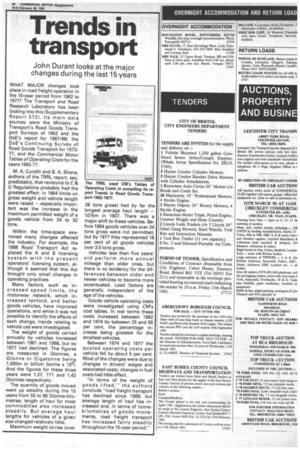Trends in transport
Page 86

If you've noticed an error in this article please click here to report it so we can fix it.
John Durant looks at the major changes during the last 15 years
WHAT MAJOR changes took place in road freight operation in the 15-year period from 1962 to 1977? The Transport and Road Research Laboratory has been looking into this (Supplementary Report 572). Its main data sources were the Ministry of Transport's Road Goods Transport Surveys of 1962 and the DoE's report for 1967/68; the DoE's Continuing Survey of Road Goods Transport for 197377; and the Commercial Motor Tables of Operating Costs for the years 1962-77, M. A. Cundill and B. A. Shane, authors of the TRRL report, say, predictably, that revisions to C & U Regulations probably had the greatest effect: in 1964 limits on gross weight and vehicle length were raised – especially important was the increase in the maximum permitted weight of a goods vehicle from 24 to 32 tons.
Within the time-space examined many changes affected the industry. For example, the 1968 Road Transport Act replaced the A and B licensing system with the present operators' licensing system, although it seemed that this Act brought only small changes in operating practices.
Many factors, such as increased speed limits, the motorway network, which increased tenfold, and better goods vehicles, have improved operations, and while it was not possible to identify the effects of each change, trends relating to vehicle use were investigated.
The weight of goods carried annually by vehicles increased between 1961 and 1968, but by 1977 had declined. The figures are measured in Gtonnes, a Gtonne or Gigatonne being 1,000m or billion (tonne x 109). And the figures for these three years were 1.27, 171 and 1.42 Gtonnes respectively.
The quantity of goods moved went up steadily during the 15 years from 55 to 98 Gtonne-kilometres; length of haul for most commodities also increased steadily. But average haul lengths for vehicles of a given size changed relatively little.
Maximum weight lorries (over 28 tons gross) had by far the longest average haul length – 107km in 1907. There was a major shift to these vehicles. Before 1964 goods vehicles over 24 tons gross were not permitted, but by 1977 they represented 18 per cent of all goods vehicles over 3.5 tons gross.
Vehicles less than five years' old perform more annual mileage than older ones, but there is no tendency for the differences between older and newer vehicles to become more accentuated. Load factors are generally independent of the age of the vehicles.
Goods vehicle operating costs were investigated using CM's cost tables. In real terms these costs increased between 1962 and 1974 by between 25 and 55 per cent, the percentage increase being greatest for the smallest vehicles.
Between 1974 and 1977 the quoted operating costs per vehicle fell by about 5 per cent. Most of the changes were due to changes in drivers' wages and associated costs; changes in fuel costs had little effect.
"In terms of the weight of goods lifted," the authors conclude "road freight transport has declined since 1968, but average length of haul has increased and, in terms of tonnekilometres of goods movements, road freight transport has increased fairly steadily throughout the 15-year period."




























































































